|
查看: 5560|回复: 54
|
有趣的church sign。。。 XD XD (51楼)
[复制链接]
|
|
|
我是用GOOGLE的翻译工具翻译的,问题是有的,
所以还是阅读英文的解说比较好罗。
[ 本帖最后由 daimon 于 4-12-2007 01:48 AM 编辑 ] |
评分
-
查看全部评分
|
|
|
|
|
|
|
|
|
|
|

楼主 |
发表于 20-10-2007 12:57 AM
|
显示全部楼层
Byzantium (ca. 330–1453)
In 330 A.D., the first Christian ruler of the Roman empire, Constantine the Great, transferred the imperial capital from Rome to the ancient city of Byzantion, renaming it Constantinople. The state ruled from that city would come to be called Byzantium, although the citizens described themselves as Rhomaioi rather than Byzantines, as they considered themselves the inheritors of the ancient Roman empire.
The Beginning of Byzantium
The first golden age of the empire, the Early Byzantine period, extended from the founding of the new capital into the 700s. Christianity replaced the gods of antiquity as the official religion of the culturally and religiously diverse state in the late 300s. Byzantium's educated elite used Roman law and Greek and Roman culture to maintain a highly organized government centered on its great cities.
The artistic traditions of the wealthy state extended throughout the empire, including the southernmost province of Egypt. In the 600s, Persian and Arab invasions devastated much of Byzantium’s eastern territories. In the 700s and early 800s, the Iconoclastic controversy raged over the proper use of religious images, resulting in extensive destruction of icons.
Middle and Late Byzantium
The resolution of the Iconoclastic controversy in favor of the use of icons ushered in a second flowering of the empire, the Middle Byzantine period (843–1261). The arts flourished, Greek became the dominant official language, and Christianity spread from Constantinople throughout the Slavic lands to the north.
In 1204, Crusaders from western Europe took Constantinople, founding the Latin Empire, which lasted
until 1261, when Byzantine rule was reestablished. The final great artistic flowering that followed lasted
until Constantinople fell to the Ottoman Turks in 1453, more than 1,100 years after its founding. Long after
its fall, Byzantium set a standard for luxury, beauty, and learning that inspired both the Latin West and
the Islamic East.
拜占庭(約330-1453 )
在公元330 ,第一基督教統治者的羅馬帝國,君士坦丁偉大的,移送帝國首都從羅馬古城byzantion ,更名,它君士坦丁堡。國務院裁定,由該城市將被稱為拜占庭,雖然公民形容自己rhomaioi而非爭,因為他們把自己視為繼承了古羅馬帝國。
年初拜占庭
第一個黃金時代的帝國,早期的拜占庭時期,延長了從建國新資金進入700s 。基督教取代了神的古風作為官方宗教的文化和宗教多元化的國家,在後期300 。拜占庭的受過教育的精英使用羅馬法與希臘羅馬文化,以維持一個高度有組織的政府圍繞著它的偉大城市。
藝術傳統的富裕國家擴大到整個帝國,包括最南端省埃及。在600 ,波斯和阿拉伯侵略蹂躪的許多拜占庭的東部領土。在700s和早期的737-800飛機, iconoclastic曾引起很大爭議,如何正確使用宗教圖像,造成廣泛破壞的圖標。
中,晚期拜占庭
解決該iconoclastic爭議,贊成使用的圖標,迎來了第二次開花的帝國,中,拜占庭時期( 843-1261 ) 。藝術發揚光大,希臘成為佔主導地位的官方語言,與基督教的傳播,從君士坦丁堡整個斯拉夫地到北方來。
在1204 ,十字軍從西歐了君士坦丁堡,創立了拉丁帝國,歷時直到1261 ,當拜占庭統治被重新確立。最後偉大的藝術開花後,歷時直到君士坦丁堡下降到奧斯曼土耳其人在1453年,已有超過1100多年後,其創始。不久秋季,拜占庭訂出一個標準,豪華,美觀,與學習,鼓舞都拉丁西和伊斯蘭東。
[ 本帖最后由 daimon 于 22-10-2007 11:30 PM 编辑 ] |
|
|
|
|
|
|
|
|
|
|
|

楼主 |
发表于 20-10-2007 01:02 AM
|
显示全部楼层
Asia Minor (Anatolia and the Caucasus), 1–500 a.d.
Ancient Greece, 1–500 a.d.
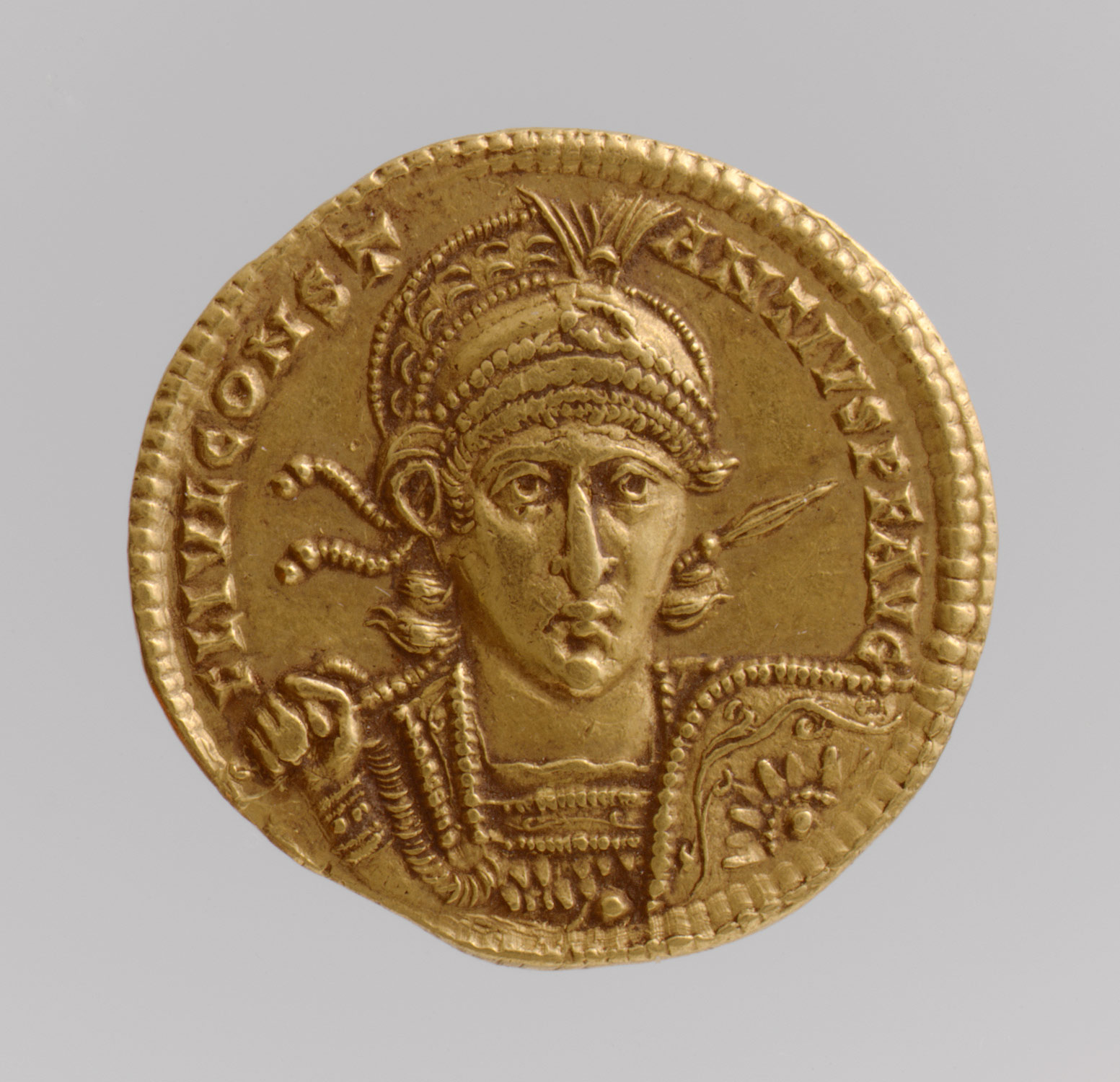
Solidus of Constantius II (Sole Emperor, 350–361), 350–361
Byzantine
Gold; Diam. 13/16 in. (2.1 cm)
Bequest of Darius Ogden Mills, 1904 (04.35.18)
This coin was struck in Rome, probably in the year 350 by Constantius II, one of the four sons of Constantine the Great. Constantius II ruled the Eastern half of the empire from 337 to 353, when he became ruler of the entire empire upon the death of his brother Constans (350) and the defeat of the usurper Magnentius (353). He is remembered for his support of Arianism (a Christian sect that had been declared heretical at the Council of Nicaea in 325), and for his construction of the original Church of Hagia Sophia in Constantinople, which Justinian would rebuild on a grander scale 200 years later.
Constantius is shown on this coin in a new portrait style, at a three-quarter angle. He wears military dress, holding a lance and a shield. On the shield is shown a sunburst motif.
這種錢幣是先後在羅馬,有可能是在今年350 constantius二,其中的四個兒子的君士坦丁大。constantius二統治東部一半的帝國從337到353 ,當他成為統治者,整個帝國去世後,他的弟弟constans的( 350)和中失敗的篡權magnentius ( 353 ) 。他記得他的支持阿里烏斯(一基督教教派已被宣布為異端邪說,在安理會的了尼西亞325 ),並為他建造的原教堂hagia索菲亞在君士坦丁堡,查士丁尼將重建一個宏偉的規模, 200多年後來。
constantius是表現出對這個錢幣在一個新的畫像作風,在三季度的角度出發。他的外衣,穿軍服,手持長矛和盾牌。對盾構是表現出sunburst題。
[ 本帖最后由 daimon 于 22-10-2007 11:29 PM 编辑 ] |
|
|
|
|
|
|
|
|
|
|
|

楼主 |
发表于 20-10-2007 01:04 AM
|
显示全部楼层
The Eastern Mediterranean, 1–500 a.d.
Ancient Greece, 1–500 a.d.
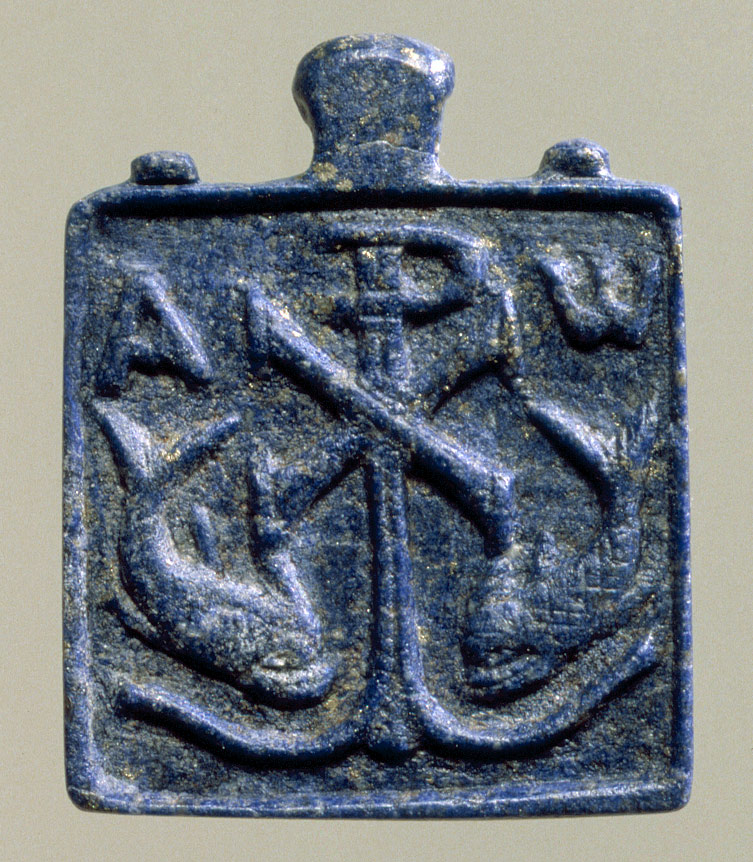
Pendant Plaque, 4th–5th century
Byzantine
Lapis lazuli; 2 3/8 x 1 15/16 x 3/16 in. (6.1 x 4.9 x .5 cm)
Purchase, Rogers Fund, Mr. and Mrs. Maxime L. Hermanos, and Anonymous Gifts, 1984 (1984.32)
This Byzantine pendant, with a suspension ring carved as part of the plaque itself, was probably made in Egypt in the fourth or fifth century. It combines four different Christian symbols and was likely worn as a protective amulet.
From top to bottom, the carvings include the first and last letters of the Greek alphabet, alpha and omega, used to symbolize God's everlasting power, and the chi rho, the first two letters of Christ's name in Greek, a symbol that we are told the Roman emperor Constantine the Great—the first emperor to convert to Christianity—saw in a vision. The chi rho broadens out to form an anchor, a popular symbol of the salvation offered by Christ. The dolphins that swim toward the anchor also have Christian significance: the Greek word ichthys (fish) could also be used as an acrostic for the Greek phrase "Jesus Christ, Son of God, Savior."
這拜占庭吊墜,暫停環刻的一部分,該牌匾本身,可能是取得了在埃及在第四或第五世紀。它集四種不同的基督教象徵,並可能在破舊作為保護的護身符。
從自上而下,上下結合,雕刻,包括第一和最後借用希臘字母,alpha和歐米茄,用來象徵上帝的永恆動力和921停機坪,首兩個字母,基督的名義在希臘,象徵這告訴我們,羅馬皇帝君士坦丁偉大-第一皇帝皈依基督教的拉鋸戰,在一個遠景。921停機坪拓寬了出來,形成一個錨是一種相當流行的象徵,在救亡圖存所提供的基督。該海豚游泳對主播,也有基督教的意義:希臘字大腸桿菌(魚),也可以被用來作為一種彰顯,為希臘短語"耶穌基督,神的兒子,救世主"
[ 本帖最后由 daimon 于 22-10-2007 11:32 PM 编辑 ] |
|
|
|
|
|
|
|
|
|
|
|

楼主 |
发表于 20-10-2007 01:06 AM
|
显示全部楼层

Ancient Greece, 1–500 a.d.
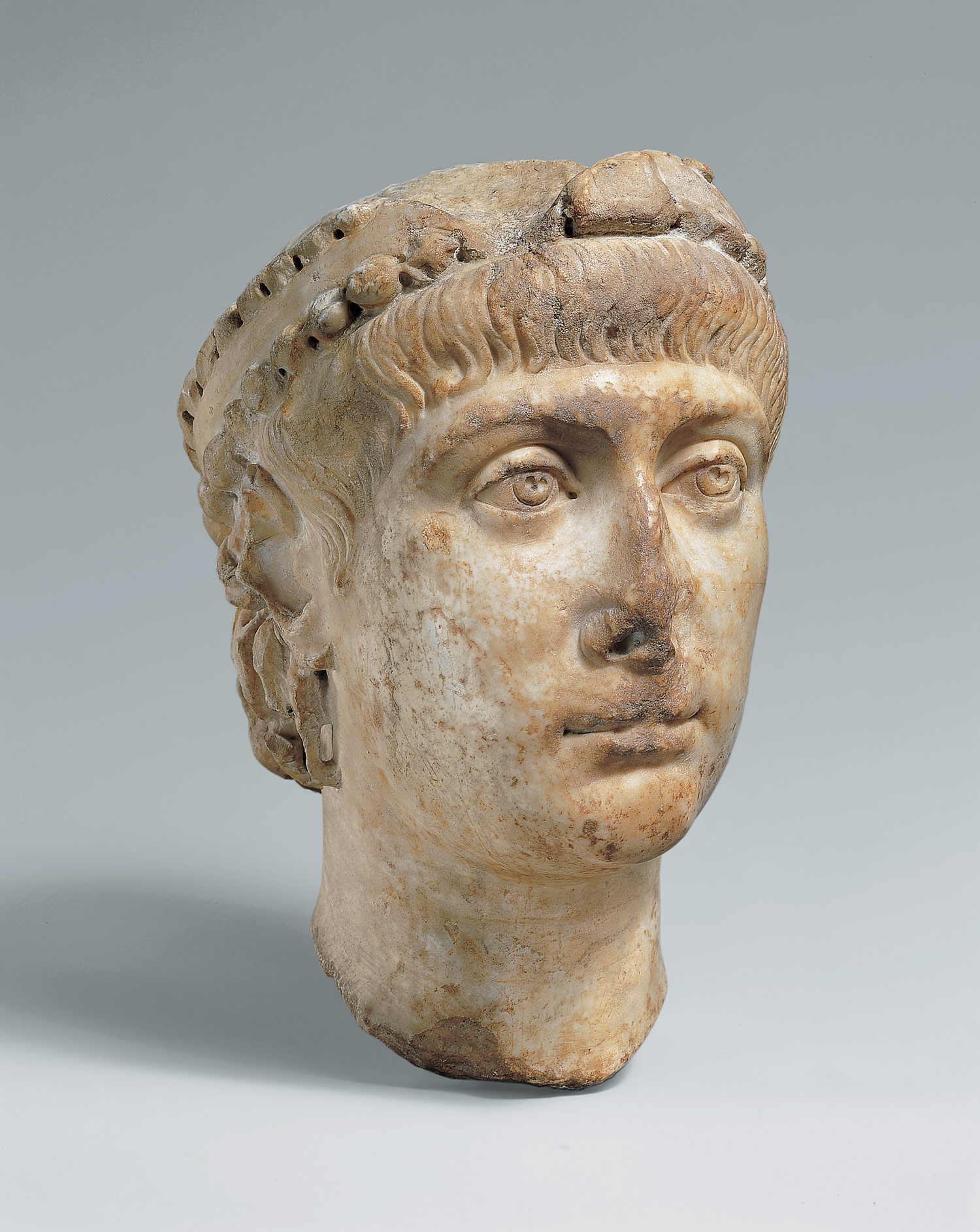
Head of Constans, ca. 337–340
Early Byzantine (Eastern Roman Empire)
Marble; Overall: 10 5/8 x 6 7/8 x 7 3/8 in. (27 x 17.5 x 18.8 cm); with base: 15 x 6 x 6 in. (38.1 x 15.2 x 15.2 cm); base: 4 3/4 x 6 x 6 in. (12.1 x 15.2 x 15.2 cm); Diam. of neck: 7 3/8 in. (18.7 cm)
Rogers Fund, 1967 (67.107)
The first Christian Roman emperor, Constantine, had four sons. This classically styled head probably represents Constans, the youngest. The head, meant for a statue, is crowned with a pearl-bordered diadem of the type worn by Constantine's family.
A devout Christian, Constans became ruler of part of the Western Roman Empire–including Italy, Africa, and much of Greece–in 337, at about age seventeen; he took command of the remainder of the western half of the empire in 340. He defeated the Franks and was the last emperor to visit Britain. In 350, before he was thirty, Constans was killed by the usurper Magnentius (r. 350—53). By the end of the fourth century, most of the Western Roman Empire was no longer under the control of Constantinople.
首基督教羅馬皇帝,君士坦丁,有四個兒子。這個經典式頭部constans的代表,年齡最小的。頭,就意味著一個雕像,是冠明珠- diadem接壤的類型所穿的君士坦丁的家庭。
作為一名虔誠的基督徒,常數成為統治者的一部分,西方的羅馬帝國-包括意大利,非洲,並取得不少的希臘- 337,約十七歲;他指揮的其餘部分,西半部帝國,在340 。他打敗了弗蘭克斯被末代皇帝將訪問英國。在350之前,他是30 ,constans的死亡是由篡權magnentius ( r. 350-53 )。到去年底,四世紀時,大部分的西羅馬帝國已不再是控制下的君士坦丁堡。
[ 本帖最后由 daimon 于 22-10-2007 11:33 PM 编辑 ] |
|
|
|
|
|
|
|
|
|
|
|

楼主 |
发表于 20-10-2007 01:08 AM
|
显示全部楼层
Western and Central Europe, 1–500 a.d.


Statuette of the Personification of Constantinople, 300–500
Byzantine
Copper alloy; 10 1/16 x 5 11/16 x 4 1/16 in. (25.5 x 14.4 x 10.3 cm)
Fletcher Fund, 1947 (47.100.40)
After Constantinople became the capital of the Roman empire in the early fourth century, small-scale statues of personifications of the city circulated throughout the empire and in distant provinces.
經過君士坦丁堡成為首都羅馬帝國,在早期的第四個世紀,規模小雕像擬人的城市散發整個帝國在遙遠的省份。
[ 本帖最后由 daimon 于 22-10-2007 11:34 PM 编辑 ] |
|
|
|
|
|
|
|
|
|
|
|

楼主 |
发表于 20-10-2007 01:17 AM
|
显示全部楼层
The Eastern Mediterranean, 500–1000 a.d.
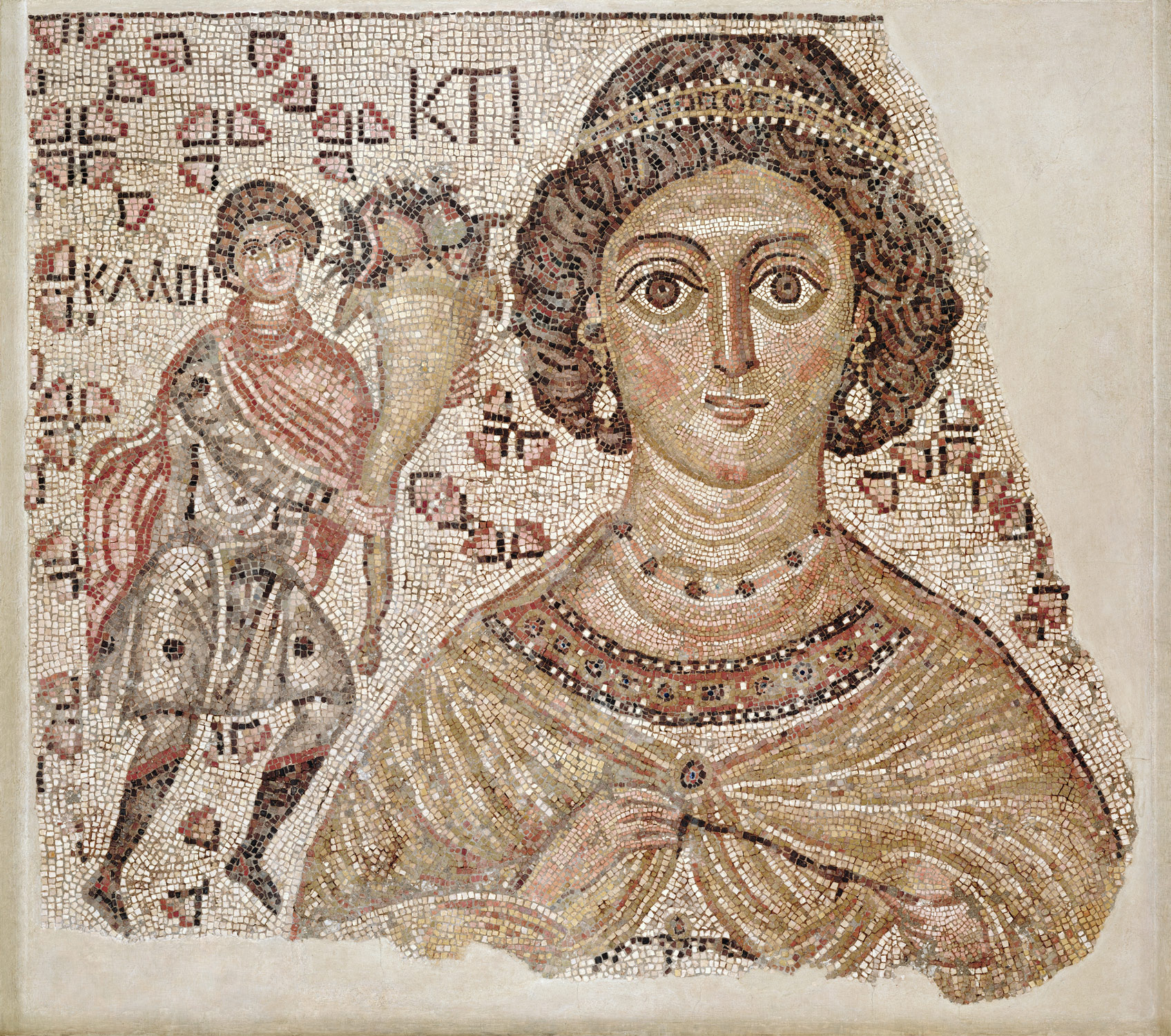
Fragment of a Floor Mosaic with a Personification of Ktisis, 500–550
Byzantine
Marble and glass; Overall 53 3/8 x 33 in. (135.6 x 83.8 cm)
Harris Brisbane Dick and Fletcher Funds, 1998 (1998.69)
Purchase, Lila Acheson Wallace Gift, and Dodge and Rogers Funds, 1999 (1999.99)
The bust of a richly bejeweled woman stares from this fragment of a floor mosaic that was once part of a large public building. The partially restored Greek inscription near her head identifies her as Ktisis, the personification of the act of generous donation or foundation. To emphasize her role as donor, she holds the measuring tool for the Roman foot. On her right a man extends a cornucopia toward her as if offering a gift; the Greek word for "good" is near his head. Originally a similar figure probably appeared to her left, and an inscription by his head would have completed the legend "Good wishes."
The classical tradition of personifying abstract ideals continued during the Christian era in many places around the Mediterranean basin, including Antioch (modern Antakya, Turkey), Cyprus, and North Africa. The carefully arranged and sized marble and glass tesserae forming this floor fragment are typical of the exceptional mosaics created throughout the Byzantine world in the 500s.
在通向一個富於的結合女子stares從這個片段的一個樓層馬賽克是曾部分大型公共建築。該部分恢復希臘碑文近頭部確定了她作為ktisis,人格化行為的慷慨捐贈或基金會。為了強調她的角色,作為捐助者,她認為,量具羅馬腳。死者右一名男子extends一個聚寶盆,對她的作為,如果提供禮品;希臘意為"良好" ,是近他的頭。本來是一個類似的數字大概在她看來,左,並題詞是由他的頭,將已完成的傳說"良好意願"
古典傳統的人物,抽象的理想,繼續在基督教時代,在許多地方圍繞地中海盆地,包括安提(現代antakya ,土耳其) ,塞浦路斯和北非。精心安排和大中大理石和玻璃tesserae成形,一樓片段是典型的特殊馬賽克創造了整個拜占庭世界,在500 s 。
KTISIS是什么意思?
http://www.searchgodsword.org/lex/grk/view.cgi?number=2937
http://seelifedifferently.blogspot.com/2006/02/kaine-ktisis-new-creation.html
[ 本帖最后由 daimon 于 22-10-2007 11:35 PM 编辑 ] |
|
|
|
|
|
|
|
|
|
|
|

楼主 |
发表于 20-10-2007 01:21 AM
|
显示全部楼层
Balkan Peninsula, 1000–1400 a.d.
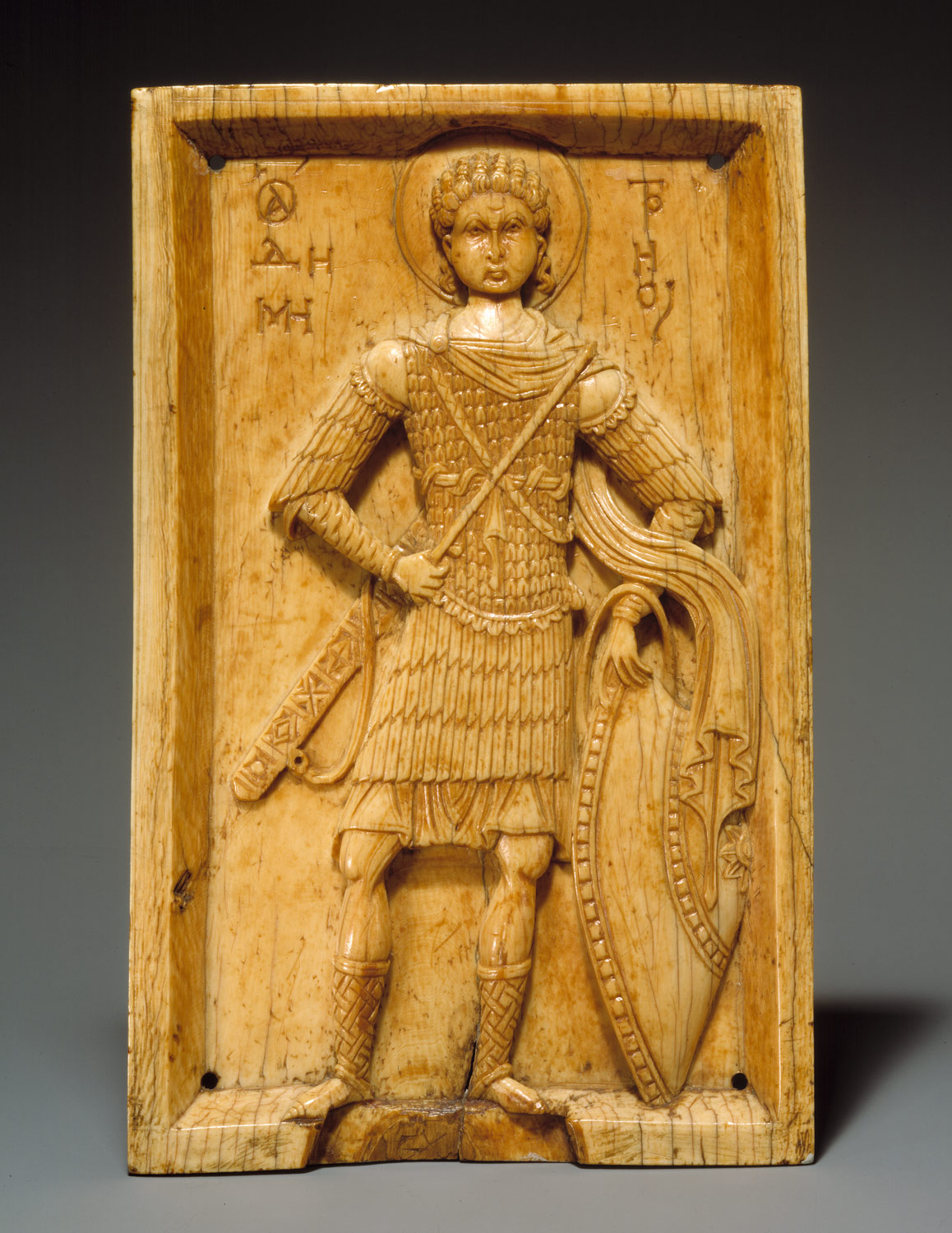
Icon with Saint Demetrios, ca. 950–1000
Byzantine
Inscribed in Greek: Saint Demetrios
Ivory; 7 3/4 x 4 3/4 x 3/8 in. (19.7 x 12.1 x 1 cm)
The Cloisters Collection, 1970 (1970.324.3)
Standing erect, spear in hand, Saint Demetrios appears ready to protect the faithful. Among the most popular of Byzantine military saints, his name is inscribed in Greek by his head. Martyred in the second city of the empire, Thessaloniki, in the early centuries of the church, he remains today the patron saint of that city. The cut-out panel at the base of the icon may have supported a standard that would have allowed the image to be carried in processions. The holes in the icon may mean that it was used as a cover for a book in the Latin West.
矗立著,長矛在手,聖demetrios似乎準備,以保障信徒。其中最受歡迎的拜占庭軍事聖人,他的名字銘刻在希臘,由他的頭部。烈屬,在第二個城市的帝國,塞薩洛尼基,我國早在幾百年的教堂,但他仍然是今天的守護神這個城市。截止列小組在該基地的圖標可能支持一個標準,即允許圖像進行遊行。該洞在圖標可能意味著它被用來作為掩護,一本書在拉美西。
[ 本帖最后由 daimon 于 22-10-2007 11:36 PM 编辑 ] |
|
|
|
|
|
|
|
|
|
|
|

楼主 |
发表于 20-10-2007 01:25 AM
|
显示全部楼层
Anatolia and the Caucasus, 1000–1400 a.d.
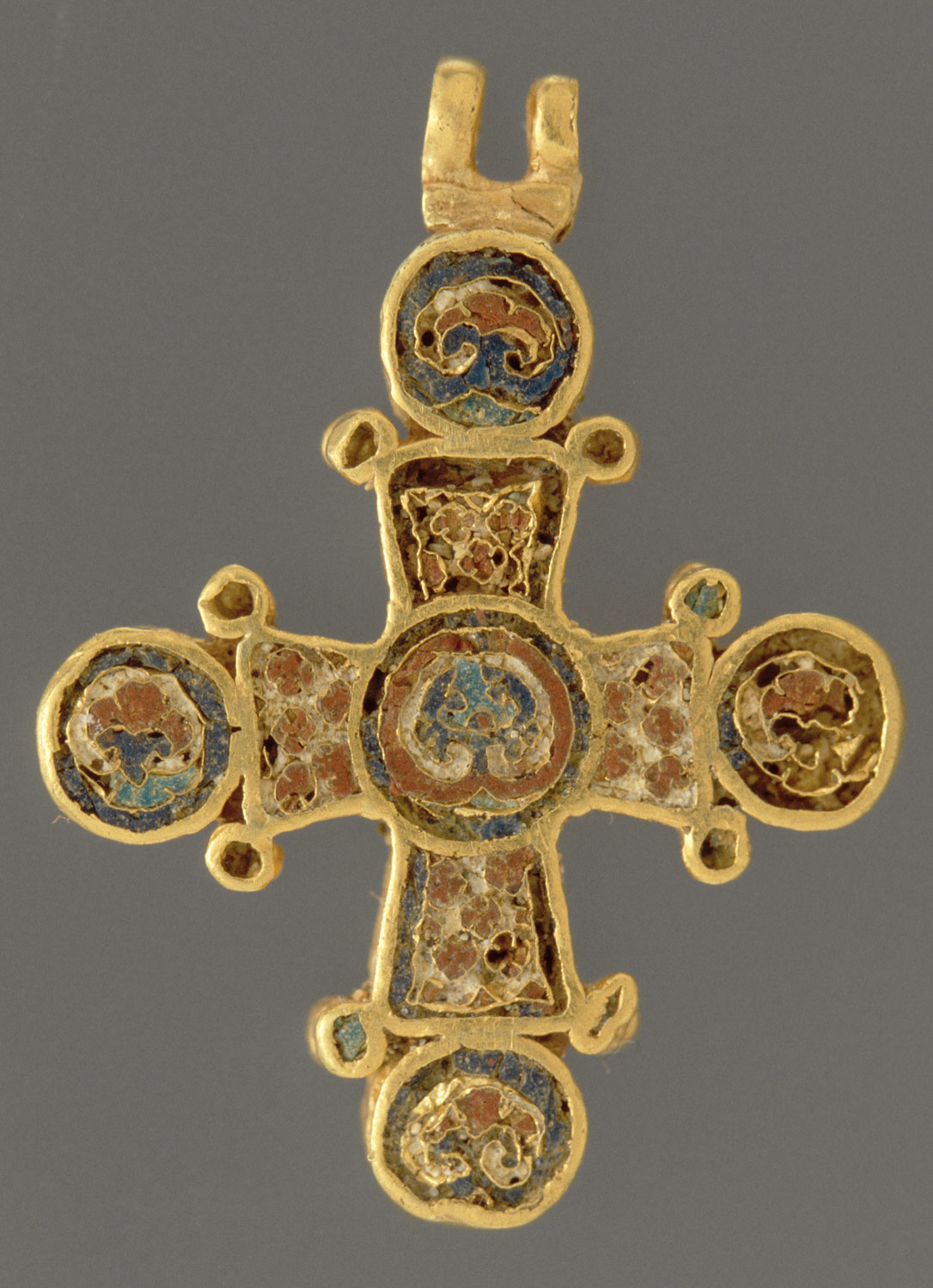
Cross Pendant, ca. 1080–1130
Byzantine; Made in Constantinople
Gold and enamel worked in cloisonné; H. 1 1/8 in. (2.9 cm)
Rogers Fund, 1998 (1998.542)
This elegant pendant cross is representative of the finest objects for personal devotion produced for the elite of the Byzantine empire. Both faces of the exquisite miniature cross are decorated with intricate floral patterns worked in multicolored cloisonné enamel, on a single sheet of gold—a tour de force of the enameler's art.
這個典雅吊墜兩岸是代表最優秀的對象為個人奉獻的製作精英的拜占庭帝國。雙方面臨的精美縮影交叉裝飾著錯綜複雜的植物圖案的工作,在彩色遺產琺瑯,就一紙黃金-環法自行車賽隊的e nameler的藝術。
[ 本帖最后由 daimon 于 22-10-2007 11:37 PM 编辑 ] |
|
|
|
|
|
|
|
|
|
|
|

楼主 |
发表于 20-10-2007 01:26 AM
|
显示全部楼层
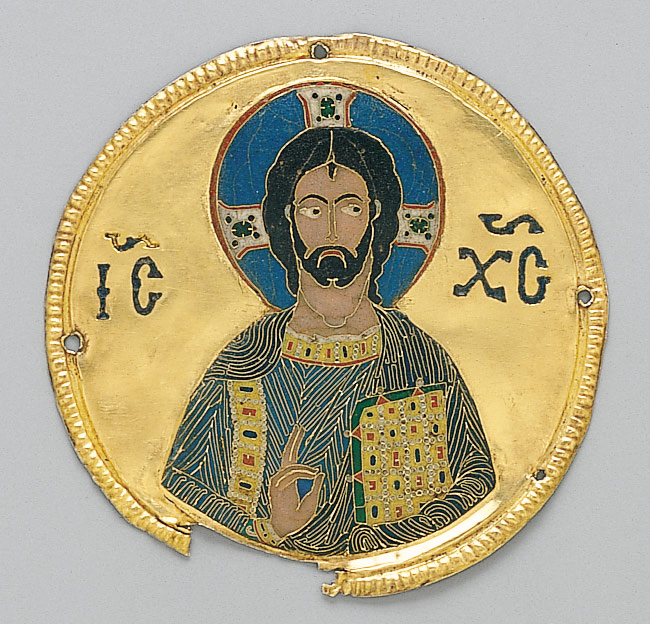
Medallion from an Icon Frame, ca. 1100
Byzantine; From the Djumati Monastery, Georgia (now Republic of Georgia); Made in Constantinople
Cloisonné enamel, gold; Diam. 3 1/4 in. (8.3 cm)
Gift of J. Pierpont Morgan, 1917 (17.190.678)
This medallion with its Greek inscriptions identifying the image as Jesus Christ, is from a group of twelve that once surrounded an icon of the Archangel Gabriel. The medallions may have been sent as a gift from the Byzantine court to the neighboring Christian state of Georgia, and are among the finest surviving examples of cloisonné enamel.
In this Byzantine technique, compartments, or cells, were outlined by thin sheets of gold or silver, filled with colored glass paste, and then fired at a high temperature, with the melting glass forming a solid surface. As in this medallion, the process often required several firings before the final polishing.
這一章與希臘銘文識別形象耶穌基督,是由一組12個,一旦包圍一個圖標的的archangel加布里埃爾。該紀念章等,可能已被送往作為禮物,從拜占庭法院周邊基督教國家的格魯吉亞,並是其中最優秀的存活例子遺產搪瓷。
在這拜占庭技術,隔間,或細胞,分別勾劃出薄板的金或銀,洋溢著彩色玻璃糊,然後發射在一個較高的溫度,與熔融玻璃形成固體表面。正如這個紀念章,這一過程往往需要幾個解聘前最後拋光。
[ 本帖最后由 daimon 于 22-10-2007 11:37 PM 编辑 ] |
|
|
|
|
|
|
|
|
|
|
|

楼主 |
发表于 20-10-2007 01:27 AM
|
显示全部楼层
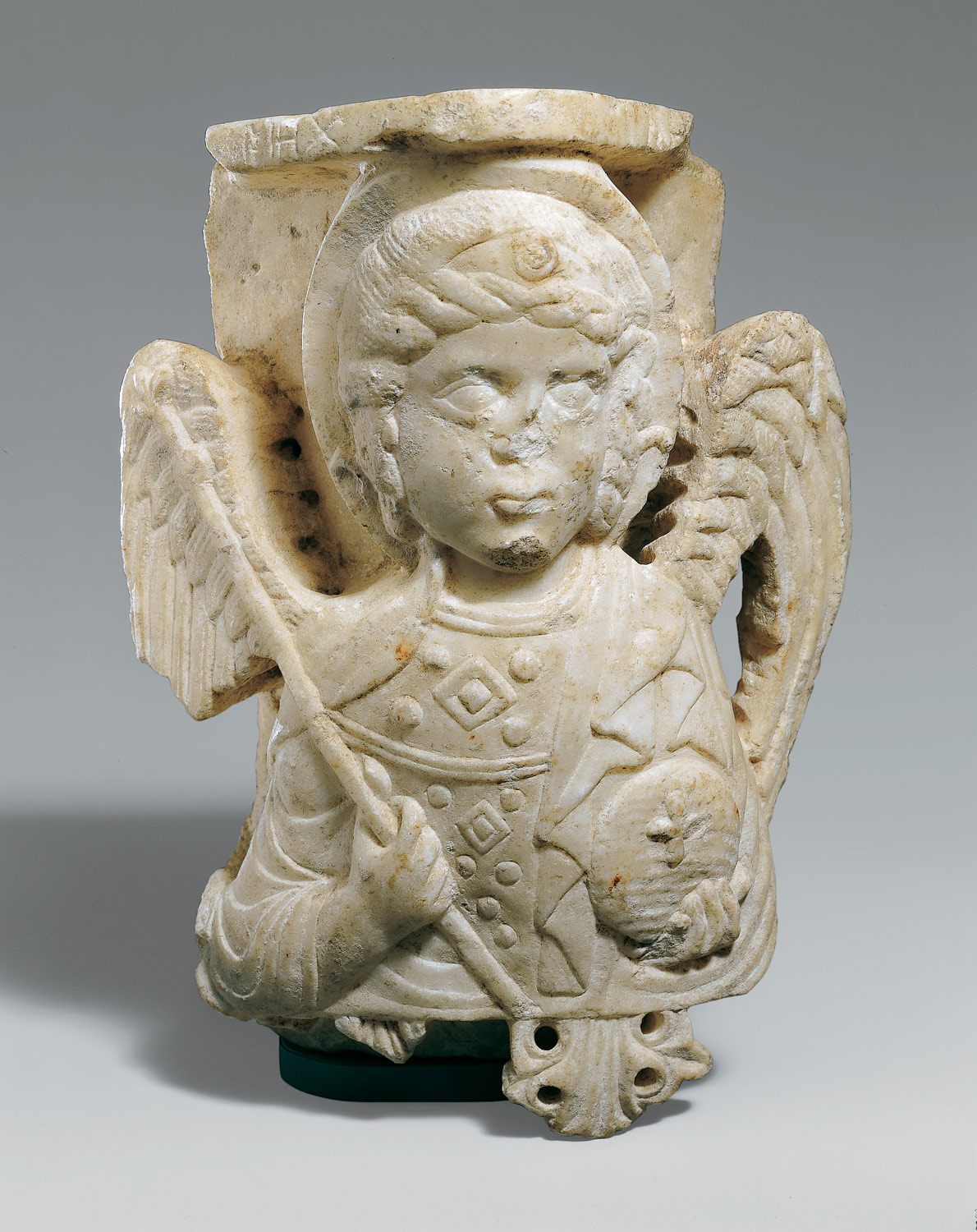
Capital with Bust of the Archangel Michael, ca. 1250–1300
Byzantine; Made in Constantinople, possibly from the Monastery of the Virgin Peribleptos ("All-Seeing"), now the Sulumanastir, a mosque
Marble; 9 3/4 x 6 7/8 x 4 1/8 in. (24.8 x 17.5 x 10.5 cm)
Purchase, Gifts of J. Pierpont Morgan, George Blumenthal and Messrs. Duveen Brothers, by exchange; Bequests of George Blumenthal and Anne D. Thompson, The Collection of Michael Dreicer, Bequest of Michael Dreicer, and Theodore M. Davis Collection, Bequest of Theodore M. Davis, by exchange; Rogers Fund and Mr. and Mrs. Maxime L. Hermanos Gift, 1983 (1983.167)
The elegant articulation of the bust on this capital is evidence of the artistic revival in Constantinople after its restoration to Byzantine rule in 1261. The archangel Michael, who is identified by an inscription in Greek, wears a jeweled tunic and a diadem and holds both an orb and a staff. These elements of dress and attributes of authority reflect the long-established connection between archangels, who are the guardians of heaven, and the Byzantine emperor, Christ's representative on earth. This image may have been part of the decoration of the upper section of a tomb built into a niche. It is said to have been found near the ruins of the Monastery of the Virgin Peribleptos (All-Seeing), established in the early eleventh century by the Byzantine emperor Romanos III Argyros (r. 1028–34), who was buried there. In the Late Byzantine period the site remained important, and the imperial court visited its church annually for the Feast of the Presentation of the Christ Child in the Temple, one of the Twelve Great Feasts (Dodekaorton) of the Orthodox Church.
優雅銜接的蕭條對這種資本是證據的藝術復甦君士坦丁堡後,其恢復,以拜占庭統治,在1261名。的archangel michael,誰是確定的題詞希臘文,戴寶石中山裝和diadem並持有既是orb與一名工作人員。這些元素的服飾和屬性管理局反映確立已久的聯繫羅迪姆,誰是監護人的天堂,拜占廷皇帝,基督的代表之一。這種形象可能已被部分裝飾上的第一個墓建成利基。據稱,已發現近廢墟中的楚布寺的維爾京peribleptos(全看) ,建立了我國早在11世紀由拜占庭皇帝羅曼諾斯三吉羅斯( r. 1028年至1034年),他是埋葬在這裡。在後期拜占庭時期工地依然重要,朝廷參觀教堂,其每年都為盛宴的介紹基督孩子在寺廟中,其中的12個偉大宴(dodekaorton )的東正教教堂。
[ 本帖最后由 daimon 于 22-10-2007 11:38 PM 编辑 ] |
|
|
|
|
|
|
|
|
|
|
|

楼主 |
发表于 20-10-2007 01:28 AM
|
显示全部楼层
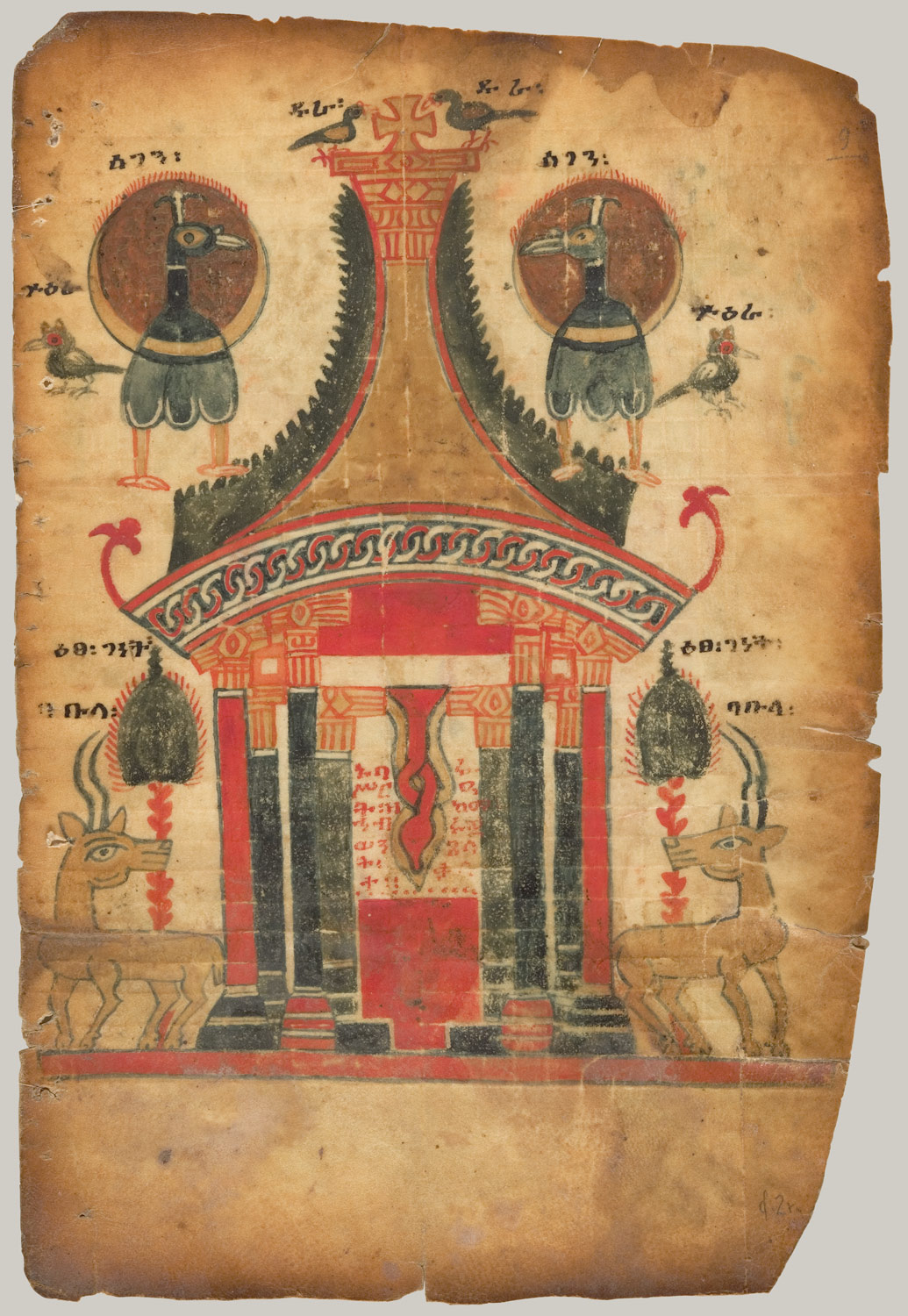
Double-Sided Gospel Leaf, first half of 14th century
Ethiopia; Tigray region
Tempera on parchment; 11 x 7 1/2 in. (27.8 x 19 cm)
Purchase, Oscar de la Renta Ltd. Gift, 2005 (2006.100)
The Tigray region of Ethiopia converted to Christianity in the fourth century and became a very important ally of the Byzantine empire, ruled from Constantinople (Istanbul), in controlling the trade routes to India. Tigray also maintained contacts with other Christian communities of the eastern Mediterranean, including those in Syria and Egypt. The compelling images on this double-sided leaf are from a group of early fourteenth-century Gospels that feature a revival of motifs that reached Ethiopia from the eastern Mediterranean, probably in the seventh century.
Both sides of the leaf are inscribed in Ge'ez, the ancient language of Ethiopia. On the front is a dramatic octagonal Fountain of Life flanked by peacocks, which are identified in the inscriptions as "ostriches" (royal birds in Ethiopia), and gazellelike "babula." The text within the domed space refers to the arrangement of the Eusebian Canon Tables, or index to the Gospels, which preceded the image in the original manuscript. On the reverse, the Crucifixion is represented by a monumental jeweled cross topped by a Lamb of God, symbol of Christ's sacrifice. At the sides are the two thieves bound to their crosses. Other leaves from this Gospel are in the Nationalmuseum in Stockholm.
提格雷地區的埃塞俄比亞皈依基督教在四世紀時,成為一個非常重要的盟友,拜占庭帝國統治,從君士坦丁堡(伊斯坦布爾),在控制其貿易路線,以印度。提格雷還保持著聯繫,與其他基督信仰團體的東地中海地區,包括那些在敘利亞和埃及。令人信服的圖像,這雙面葉是從一組早在第十四世紀福音那種功能復甦的圖案達到埃塞俄比亞從地中海東部,有可能是在公元7世紀。
雙方的葉片是銘刻在ge'ez,古代語言的埃塞俄比亞。在前面是一個巨大的八角型噴泉的生活,兩旁是孔雀,這是確定的題字為"鴕鳥" (英國皇家鳥類在埃塞俄比亞),並gazellelike"鮑布洛"文內圓頂空間,是指以安排的eusebian佳能桌,或索引,以福音書,其中前面的形象在原稿。就反過來,在十字架上都代表了一個不朽的寶石交叉突破,由羔羊的上帝,象徵基督的犧牲。在兩岸是兩個小偷約束自己的十字架。其他樹葉從這個福音是在nationalmuseum在斯德哥爾摩。
[ 本帖最后由 daimon 于 22-10-2007 11:38 PM 编辑 ] |
|
|
|
|
|
|
|
|
|
|
|

楼主 |
发表于 20-10-2007 01:29 AM
|
显示全部楼层
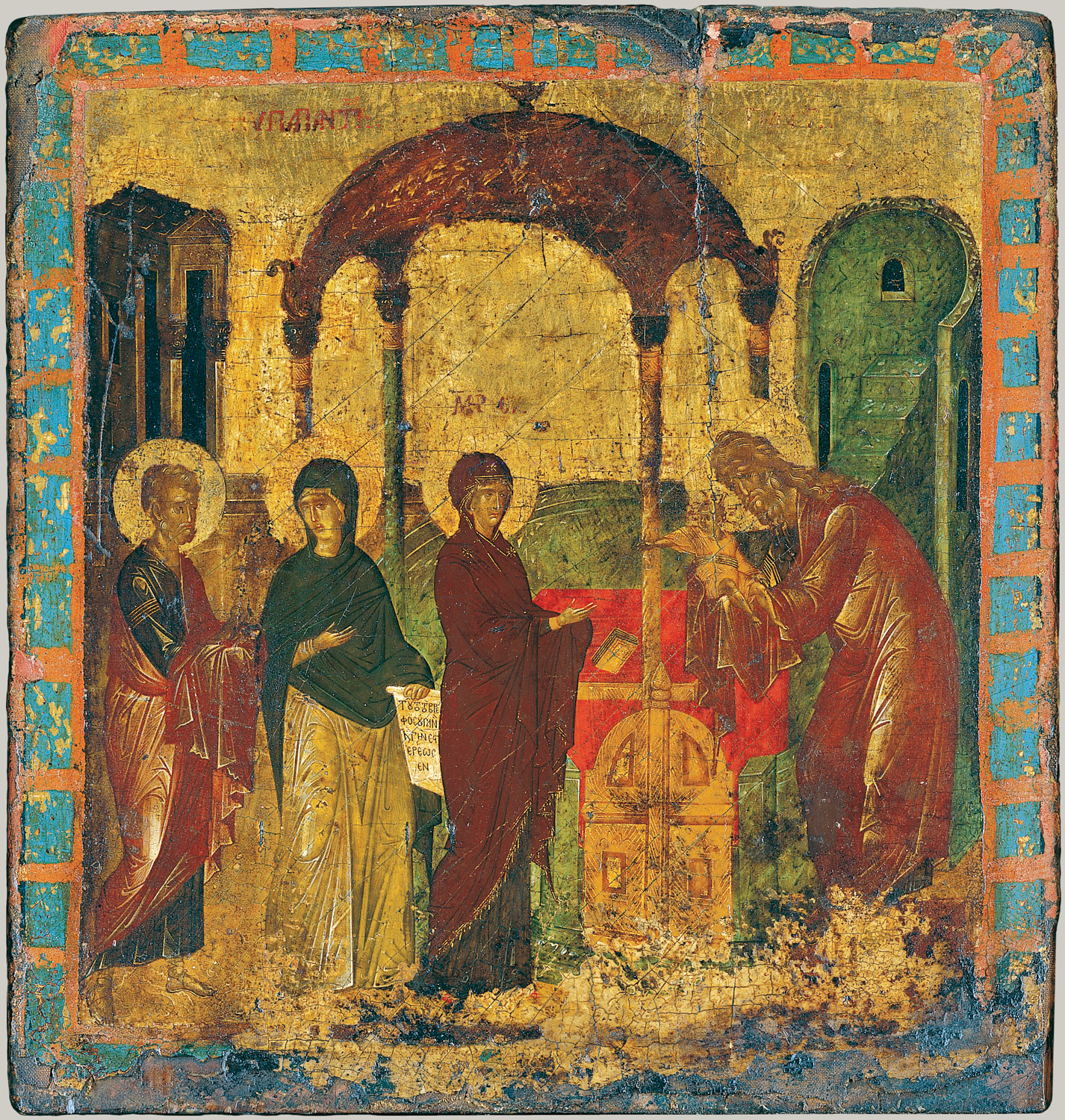
Icon with the Presentation of Christ in the Temple, 1400–1500
Byzantine
Wood, painted, with gold ground; 17 1/2 x 16 5/8 in. (44.5 x 42.2 cm)
Bequest of Lillie P. Bliss, 1931 (31.67.8)
Icons painted on wood were the principal objects of religious devotion in the last centuries of Byzantium. Identified by a Greek inscription as "the Purification," this icon shows the Virgin presenting the Christ Child to Simeon for the customary rite of purification at the temple. Like Simeon, the prophet Anna (between Joseph and Mary) recognized the child's divinity, as indicated by the Greek text on the scroll in her hand: "This child created Heaven and Earth."
圖標手繪於木材分別為主體對象的宗教奉獻,在過去幾個世紀的拜占庭。確定由一名希臘碑文為"淨化",這圖標顯示,維爾京介紹了基督的孩子西蒙為習慣成年禮的純化在廟埕。像西蒙,先知安娜(介乎約瑟夫和瑪麗)認識到孩子的神性,如由希臘文字長卷,在她的手: "這孩子創造天地"
[ 本帖最后由 daimon 于 22-10-2007 11:39 PM 编辑 ] |
|
|
|
|
|
|
|
|
|
|
|

楼主 |
发表于 22-10-2007 12:02 PM
|
显示全部楼层
Medieval Art -The Age of Saint Louis (1226–1270)
"Wecame to the sands of Acre, where we pitched camp, the King [Louis IX]and the host. Thither in that place came to me a troop of many peoplefrom Great Armenia, that were going on pilgrimage to Jerusalem … By aninterpreter … they begged me that I would show them the saintly King. Iwent to the King where he sate in a pavilion, leaning against the poleof the pavilion … I said to him: 'Sir, there is without a band of manyfolk from Great Armenia, that are going to Jerusalem, and they pray me,Sir, that I have them shown the saintly King; but I have no wish yet tokiss your bones.' And he laughed aloud and told me to go to fetch them;and so I did."
Thus Jean, sire de Joinville, friend and Crusader in the company of Louis IX of France, describes the degree to whichpeople venerated the king as a saint even during his lifetime.Following his death, nearly 400 witnesses gathered at Saint-Denis totestify to his sanctity. There, in the royal abbey, a chapel came to bededicated to Saint Louis (Two Grisaille Panels, 1982.433.3,4). There the faithful—and, in particular his own descendants—came to pray and honor his example (The Hours of Jeanne d'Évreux, 54.1.2),for during his long reign (1226–70), both the saintly king and thenation thrived, and the city of Paris was firmly established as thepremier artistic and intellectual center of Europe. At the end ofLouis's reign, 101 different craft guilds were established in the city;the university welcomed scholars and students from across Europe.
Louis IX and the Sainte-Chapelle
We knowfrom Louis's biographers that "From the beginning when he came to holdhis realm and knew himself of discernment, he began to build churchesand many religious houses …" Most celebrated was the Sainte-Chapelle,his royal chapel on the Île de la Cité in Paris. Built to enshrine the relics of Christ's Passion, it was consecrated on April 26, 1246. The stained glass of the chapel celebrates Louis's acquisition of the relics (Stained-Glass Panel, 37.173.3). But it was clearly a site for Louis's private devotionsas well, and his biographer tells of the king's sometimes acrobaticreligious fervor: "I went to the King's chapel and found the King, whohad mounted on the gallery of the relics, and had caused them to takedown the True Cross."
Art under Saint Louis
Louis IX was a key supporter of the Franciscan and Dominican orders. An ivory diptych (Diptych with the Last Judgment and Coronation of the Virgin, 1970.324.7a-b) shows a mendicant friar being led up the ladder to heaven, followed by the image of a king, avisual testament to the important role played by Franciscan andDominican confessors at the royal court. The Bible made in Paris(Bible, 1997.320)includes the profile of a Dominican friar kneeling beneath theCrucifixion. More sumptuous still is the Crucifixion from a missal(Leaf from a Missal, 1981.322). By the middle of the thirteenth century at least, book dealers selling manuscripts like these were established in Paris, on the Left Bank by the university, and in front of Notre-Dame on the Île de la Cité.
Not only Dominican andFranciscan establishments flourished during the reign of Saint Louis.In the Lady Chapel at the Benedictine Abbey of Saint-Germain-des-Prés,stained glass rivaling that at the Sainte-Chapelle was installedbetween 1244 and 1255, almost coincident with the completion of theSainte-Chapelle (Scenes from the Passion of Saint Vincent of Saragossaand the History of His Relics, 24.167a-k); new sculpture further enriched the Cathedral of Notre-Dame and other churches of Paris (Head of an Angel [?], 1990.132).
The Death of Saint Louis
Louis twiceparticipated in Crusades to recapture the Holy Land, bringing his courtinto the broader international arena. He died in Tunis while onCrusade; in a depiction of the procession of his relics, the casketbearing his body is set on a rich and exotic silk of the type prized inEast and West alike (Silk with Griffins, 1984.344).
中世紀藝術的年齡聖路易斯( 1226年至1270年)
" wecame向砂英畝,而我們宿營,國王[路易九]與東道國。 thither在那個地方來找我,部隊,許多民大亞美尼亞,那將會對耶路撒冷朝聖……由aninterpreter …他們央求我,我會證明他們聖潔的國王。 iwent向國王那裡,他sate在一個展館,傾向於對poleof涼亭……我對他說:'主席先生,有沒有一個波段的manyfolk從偉大的亞美尼亞,這是前往耶路撒冷,與他們祈求主席先生,我認為我對他們表現出德雷克景;不過我不打算尚未tokiss你的骨頭。 '他哈哈一笑自言自語,並告訴我到成交價;所以,我做到了。 "
從而讓,父系德約恩維利,朋友和十字軍在該公司的路易第九的法國,形容程度whichpeople崇敬國王為聖人,甚至在他lifetime.following他死後,有近400名證人,聚集在聖但尼totestify他神聖不可侵犯的。在那裡,在皇家修道院,教堂來到bededicated到聖路易斯(兩個grisaille面板,1982.433.3,4 ) 。有忠誠和,特別是他對自己的子孫-來祈求和榮譽為他的榜樣(小時珍妮德é vreux, 5 4.1.2),在他的長期統治( 1 226至1 270年),無論是聖潔的國王和thenation蓬勃發展,和城市巴黎的是牢固地確立為thepremier藝術和智力歐洲的中心。在去年底oflouis的統治, 101名不同工藝會館設立於市;大學歡迎學者和學生從歐洲各地。
路易九和聖chapelle
我們knowfrom路易斯的傳記作者說:"從一開始,當他來到holdhis境界,知道自己的鑑別力,他開始組建churchesand許多宗教房子… … "最著名的是聖chapelle,他的皇家教堂就區以及ile德洛杉磯城在巴黎舉行。建成以體現古代文物的基督的激情,這是consecrated於1246年4月26日。染色玻璃的教堂慶祝路易的採集的文物(染玻璃板, 37.173.3 )。但它顯然是一個站點,為路易的私人devotionsas好,和他的傳記作者告訴了國王的,有時acrobaticreligious侃侃而談:"我去國王的教堂,並發現國王,下面鑲嵌在展廳的文物,已造成他們takedown真正的交叉。 "
藝術下聖路易斯
路易九,是一個關鍵的支持者濟和多米尼加訂單。象牙雕刻(雕刻與上次的判斷和加冕典禮的處女,1970.324.7a乙)顯示乞討弗萊爾正率領了梯子上天堂,其次是形象的一個國王,avisual證明所起的重要作用由方濟各anddominican confessors在皇家法院。聖經在巴黎(聖經, 1997.320)包括概況,多米尼加弗萊爾跪在下方thecrucifixion 。更豐盛的仍然是在十字架上,從missal (葉從missal ,1981.322 ) 。由中間的13世紀,至少,書商賣手稿喜歡這些設立在巴黎,對左岸由大學,並在前面的聖母-貴婦人對區以及ile德洛杉磯城。
不僅多米尼加andfranciscan場所蓬勃統治期間,聖louis.in夫人教堂,在篤會修道院的聖-隊-號- prés,彩色玻璃勢均力敵,在聖chapelle是installedbetween1244號決議和1255名,幾乎是偶然的巧合,以完成對thesainte - chapelle(場景,從激情的聖文森特的saragossaand歷史,其遺跡, 24.167a鉀);新的雕塑,進一步豐富了大教堂的聖母-貴婦人和其他教會的巴黎(團長天使[ ? ] , 1990.132 ) 。
死亡聖路易斯
路易twiceparticipated在十字軍奪回聖地,使他courtinto更廣泛的國際舞台。他死在突尼斯,而oncrusade;在一個寫照遊行,他的遺物, casketbearing他的遺體定於一個富裕和異國情調的絲綢種類珍貴ineast和西都(絲綢與磅,1984.344 ) 。
[ 本帖最后由 daimon 于 22-10-2007 11:41 PM 编辑 ] |
|
|
|
|
|
|
|
|
|
|
|

楼主 |
发表于 22-10-2007 12:04 PM
|
显示全部楼层
France, 1000–1400 a.d.
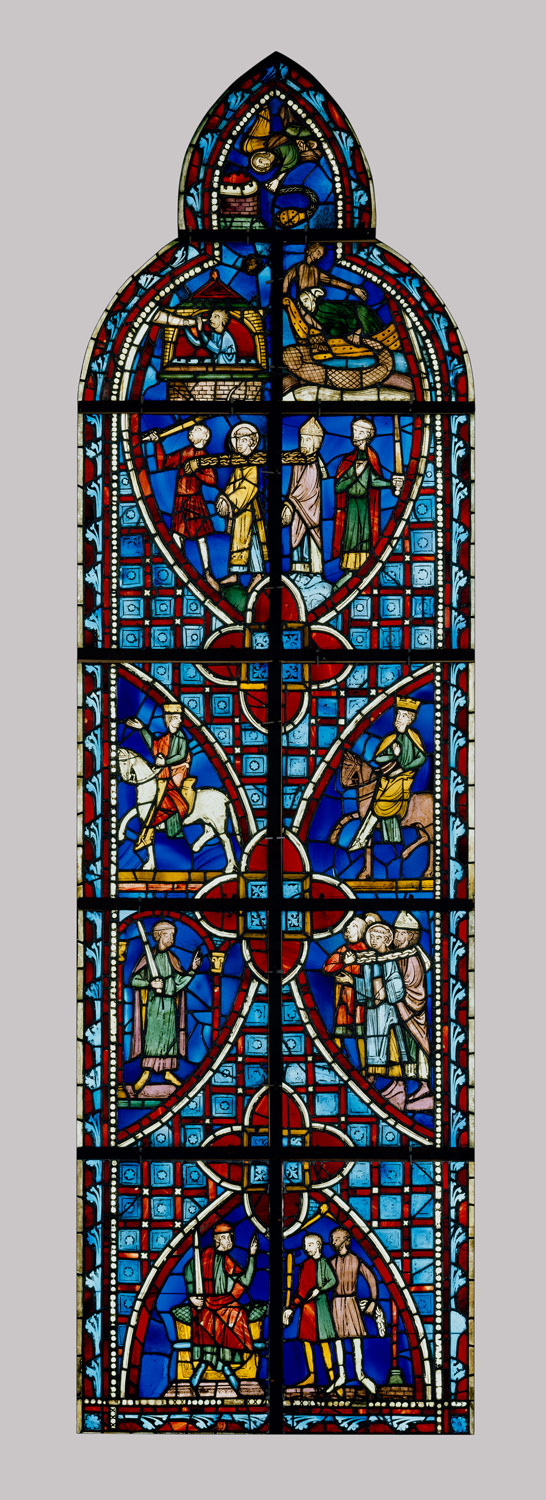
Scenes from the Passion of Saint Vincent of Saragossa and the History of His Relics, 1244–1247
French; From the Church of St. Germain-des-Prés, Paris
Pot-metal glass with vitreous paint; 147 x 43 1/2 in. (373.4 x 110.5 cm)
Gift of George D. Pratt, 1924 (24.167a–k)
Thesepanels were originally part of two large windows depicting themartyrdom of the deacon, Saint Vincent of Saragossa (d. 304), and thehistory of his relics, from the Church of Saint-Germain-des-Prés inParis. The monks of Saint-Germain-des-Prés held a special devotion forVincent—their abbey had been founded to receive a relic of the saint'stunic, which had been transported from Spain by the Merovingian kingChildebert I. The king and his brother Chlotar are shown here onhorseback. The remaining scenes illustrate Saint Vincent'sconfrontations with the Roman proconsul Dacian. Bold silhouettes definetall, lithe figures, whose prominent gestures convey a narrativeemphasizing Saint Vincent as an exemplar of Christian piety in defianceof pagan authority.
thesepanels原本的一部分兩個大窗描繪themartyrdom的執事,聖文森特的薩拉戈薩(四304 ),並thehistory他的遺物,從教堂的聖-隊-號- prés 3,687.53 。僧人聖隊-號-prés舉行了一次特別奉獻forvincent -他們修院已成立接收舍利子的saint'stunic,已被運往西班牙,由沙盒kingchildebert一,國王和他的弟弟都是chlotar這說明onhorseback。剩下的場面,說明聖vincent'sconfrontations與羅馬proconsul達奇安。大膽預言definetall,柔人物,其突出的手勢傳達一個narrativeemphasizing聖文森特作為範例的虔誠基督徒,在defianceof異教徒權威。
[ 本帖最后由 daimon 于 22-10-2007 11:42 PM 编辑 ] |
|
|
|
|
|
|
|
|
|
|
|

楼主 |
发表于 22-10-2007 12:06 PM
|
显示全部楼层
France, 1000–1400 a.d.
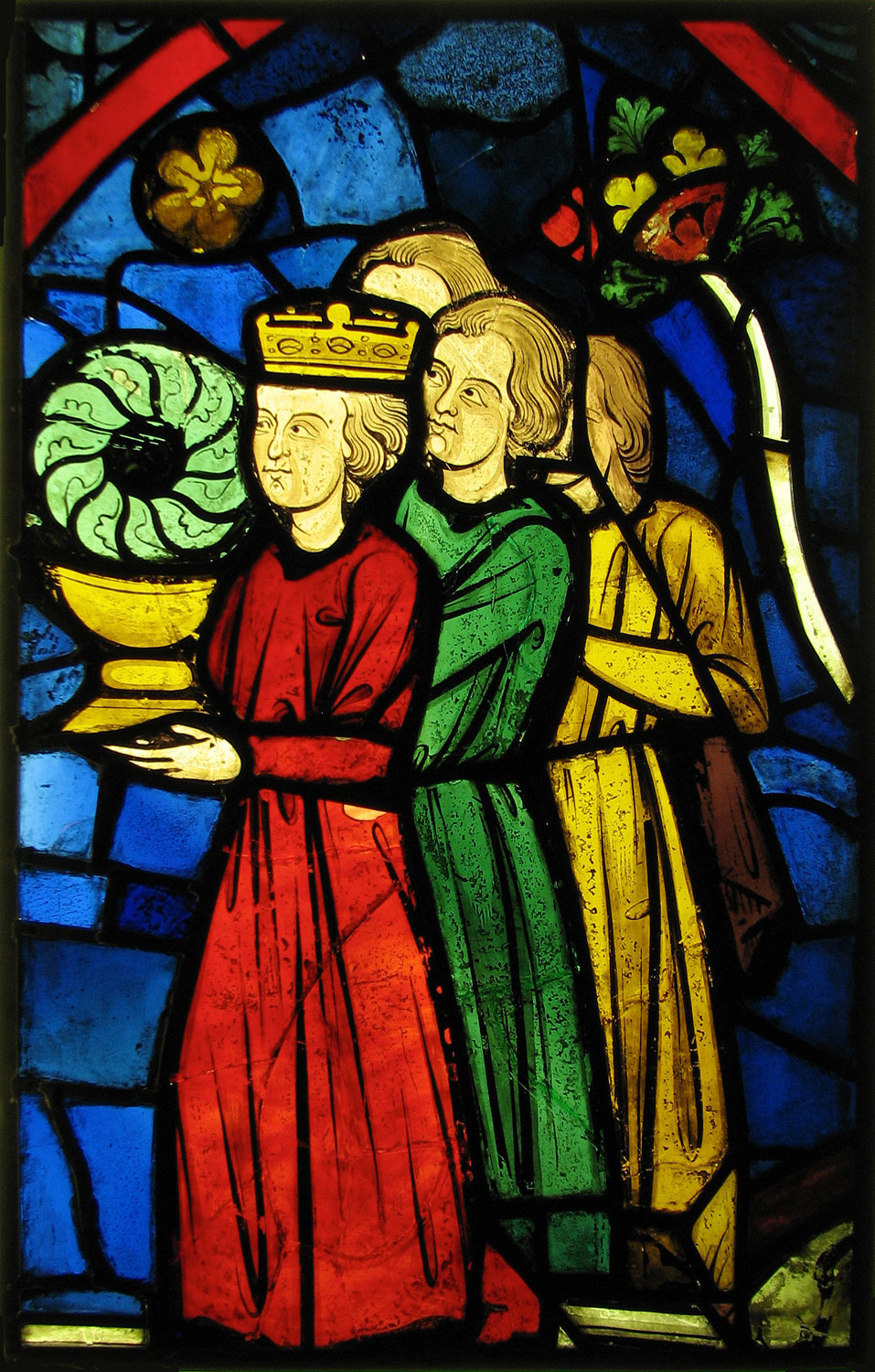
Stained-Glass Panel, ca. 1245–1248
France, Tours, Ambulatory of the Cathedral of Saint-Gatien
Pot-metal glass and vitreous paint; 21 x 13 1/2 in. (53.3 x 34.3 cm)
The Cloisters Collection, 1937 (37.173.3)
KingLouis IX of France (r. 1226–70), later Saint Louis, undertook twocrusades to the Holy Land. He acquired relics of Christ's passion fromhis cousin, the Lahn emperor of Constantinople Baldwin II, most notablya piece of the True Cross and also the Crown of Thorns. He broughtthese relics to Paris and installed them in the Sainte-Chapelle, achurch that he had built to house them. According to a contemporarychronicle, on the way to Paris Louis stopped at Sens, where the Crownof Thorns was placed in the cathedral overnight. This panel shows Louisat Sens with his brother and some courtiers. Clad in simple clothes,the crowned King Louis carries the extraordinary relic atop a chalice.
kinglouis第九法國( r. 1226年至1270年) ,後來聖路易斯,答應twocrusades前往聖地。他收購文物的基督的激情fromhis表姐,lahn皇帝的君士坦丁堡鮑德溫二,最notablya一塊真正的交叉,也是皇冠荊棘滿途。他broughtthese文物巴黎並把他們安裝在聖chapelle , achurch他已建成可容納他們。根據一項contemporarychronicle,就未來路向巴黎路易停在意義,而crownof荊棘被放置在教堂過夜。這個小組顯示louisat意義與他的兄弟和一些王室。穿簡單的衣服,榮登國王路易進行了不平凡的舍利子北京時間宗徒。
[ 本帖最后由 daimon 于 22-10-2007 11:43 PM 编辑 ] |
|
|
|
|
|
|
|
|
|
|
|

楼主 |
发表于 22-10-2007 12:07 PM
|
显示全部楼层
France, 1000–1400 a.d.
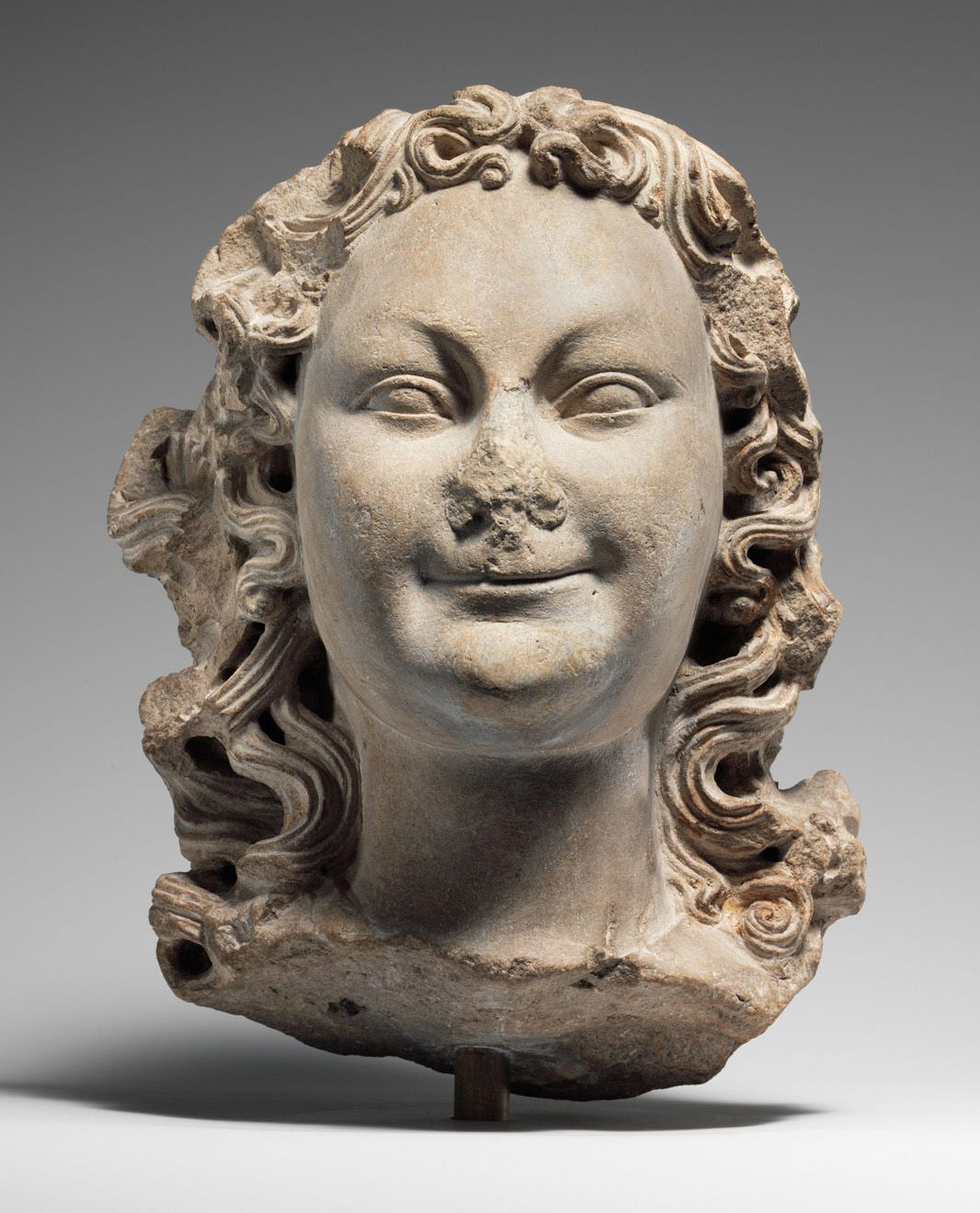
Head of an Angel, ca. 1250
France, Paris, Notre-Dame Cathedral (?)
Limestone; H. 9 5/8 in. (24.5 cm)
Purchase, Michel David-Weil Gift, 1990 (1990.132)
Beautyand tenderness mark the irresistible appeal of this angelic head, which possesses both a precociousness and a playfulness rarely seen in High Gothic sculpture. The deeply undercut elastic and cascading locks ofhair; the suggestive, tight-lipped smile; and the refinement of the surface help place the work at the forefront of Parisian Gothic sculpture, about the middle of the thirteenth century. The style of the sculpture and the type of limestone used suggest that this head comes from Notre-Dame of Paris, probably from its choir screen.
跟她對唱壓痛標誌不可抗拒的吸引力,這天使的頭,其中擁有既是一種早熟和玩興罕見的高哥特式雕塑。深削弱彈性和級聯鎖的頭髮;該暗示,守口如瓶的笑容;和細化,表面上幫助地方工作,走在巴黎的哥特式雕塑,約中的13世紀。風格的雕塑和類型的石灰石用於顯示這頭來自聖母-貴婦人的巴黎,大概從它的合唱團幕。
[ 本帖最后由 daimon 于 22-10-2007 11:44 PM 编辑 ] |
|
|
|
|
|
|
|
|
|
|
|

楼主 |
发表于 22-10-2007 12:09 PM
|
显示全部楼层
France, 1000–1400 a.d.
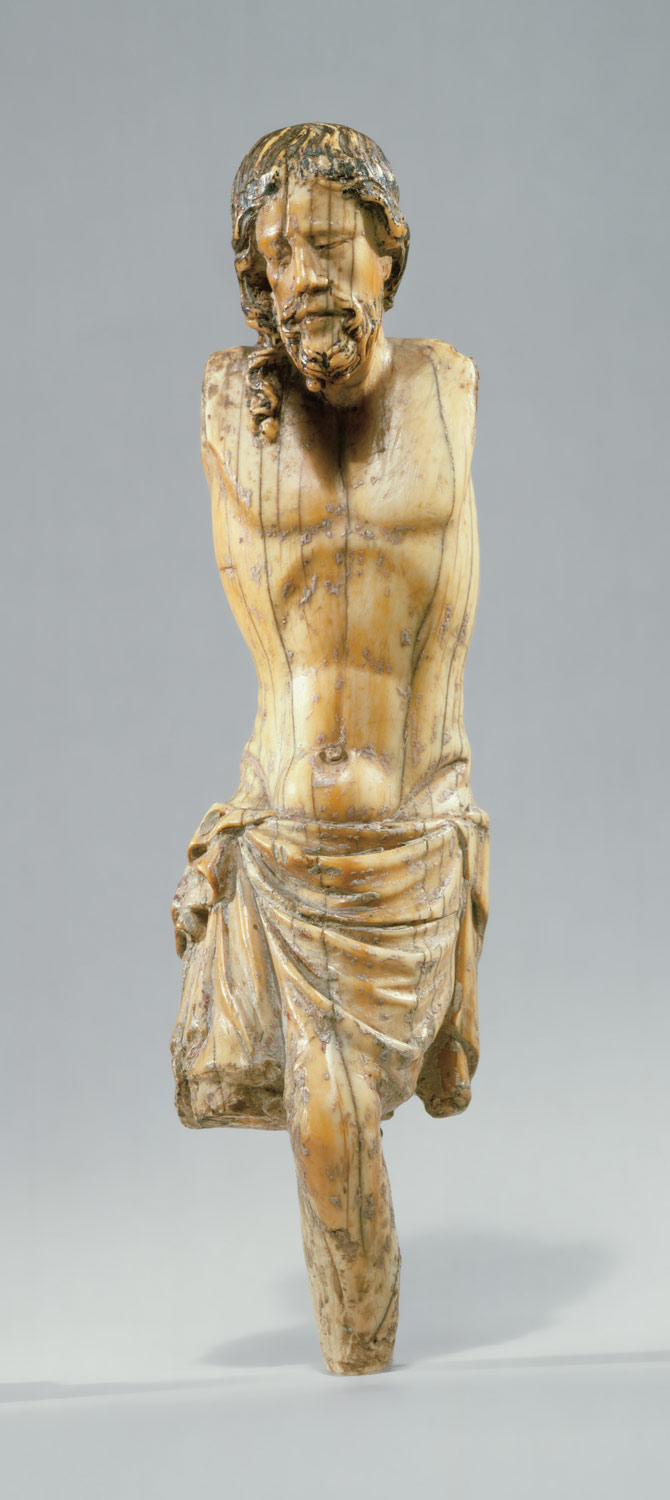
Corpus of Christ, ca. 1250
French; Possibly made in Paris
Elephant ivory, traces of paint; 6 5/8 x 1 11/16 x 1 5/16 in. (16.8 x 4.3 x 3.4 cm)
Gift of Mr. and Mrs. Maxime L. Hermanos, 1978 (1978.521.3)
Thetheme of Christ's suffering on the cross was so important in Gothic artthat the mid-thirteenth-century statute of the corporations of Parisprovided for a guild dedicated to the carving of such images, includingones in ivory. This ivory sculpture of Christ, whose pathos and agonyare beautifully conveyed, was executed in the round and most certainlywas intended for an altar cross. In spite of the loss of both arms andparts of the legs (which originally were attached to the body by meansof pegs), the modeling of the figure reveals a profound sensitivity toform and expression. The powerful anatomical structure—with its naturalportrayal of the dying Christ's corporeality—is remarkable for acrucifix of this period. The closed eyes and the long hair, which fallsdown the back and right side of the head, reveal the emotional impactof death. A subtle twist in the torso was produced in part by thepositioning of the legs, which were crossed and mounted on the crosswith a single tail.
主題為基督的痛苦,對兩岸是如此重要,在哥特式藝術中的第十三世紀規約該公司在巴黎提供了一個協會專門為雕刻此種圖像,包括象牙。這個象牙雕刻的基督,他們的感傷和痛苦,是美輪美奐,傳達了被執行死刑,在全面和最肯定的用意是為供奉交叉。儘管失去雙臂和零部件的雙腿(原本附在身體的方式釘住),模擬的數字揭示了一個深刻的敏感性,形式和表達。強大的解剖結構與天然寫照臨終基督的corporeality-是了不起的十字架這一時期。封閉式眼睛和長頭髮,其中摔倒背部和右側頭部,揭示情感撞擊死亡。一個微妙的扭曲,在軀幹製作部分由定位的腿部,其中跨越,並展開對兩岸關係具有單一的尾巴一樣。
[ 本帖最后由 daimon 于 22-10-2007 11:46 PM 编辑 ] |
|
|
|
|
|
|
|
|
|
|
|

楼主 |
发表于 22-10-2007 12:11 PM
|
显示全部楼层
France, 1000–1400 a.d.

Diptych with the Last Judgment and Coronation of the Virgin, ca. 1250–1270
French; Paris
Elephant ivory; Each panel H. 5 in. (12.7 cm), W. 2 1/2 in. (6.5 cm)
The Cloisters Collection, 1970 (1970.324.7a–b)
Conceived as sculpturein high relief, this diptych telescopes two leading themes of theGothic era: the Last Judgment and the Coronation of the Virgin. Eachscene is presented in two zones. Above, on the right, is ChristEnthroned in Judgment displaying his wounds, with angels holdinginstruments of the Passion and the Virgin and Saint John kneeling inprayer. Below, angels trumpet the fate of the risen while the damnedare pitched into the Mouth of Hell. On the left is the Coronation ofthe Virgin by an angel in the presence of Christ, while below, aretinue of the saved souls—including a mendicant friar, a king, a pope,and possibly a deacon—is ushered up a ladder to a celestial paradise byan angel who points the way.
The precision of forms with deeply undercut figures produces anexceptional degree of sculptural projection. The noble gestures ofveneration and the supple, full draperies are characteristic of thecourtly tendencies of Paris during the middle of the second half of thethirteenth century.
設想為雕塑高救濟,這眺望望遠鏡兩大主導主題的哥特時代:最後的判斷和加冕的童貞。每一個場景是在兩個區域內。上述情況,對正確的,是命名throned判斷,顯示他的傷口,與天使控股文書的激情和維爾京和聖約翰跪在地上禱告。下面,天使小號命運的復活而該死是定到口的地獄。就在左邊,是加冕的處女由天使在在場的基督,而在下面,一名侍從的節省下來的靈魂-包括一個乞討弗萊爾,一個國王,教皇,並可能為執事,正迎來了一個階梯開天樂園,由天使的人指明了道路。
精密的形式與深入削弱數字製作平常程度的雕塑投影。高貴的姿態,敬仰和補充,充分draperies有特點的宮廷傾向巴黎,在中,下半年的13世紀。
[ 本帖最后由 daimon 于 23-10-2007 11:16 PM 编辑 ] |
|
|
|
|
|
|
|
|
|
|
|

楼主 |
发表于 22-10-2007 12:13 PM
|
显示全部楼层
France, 1000–1400 a.d.
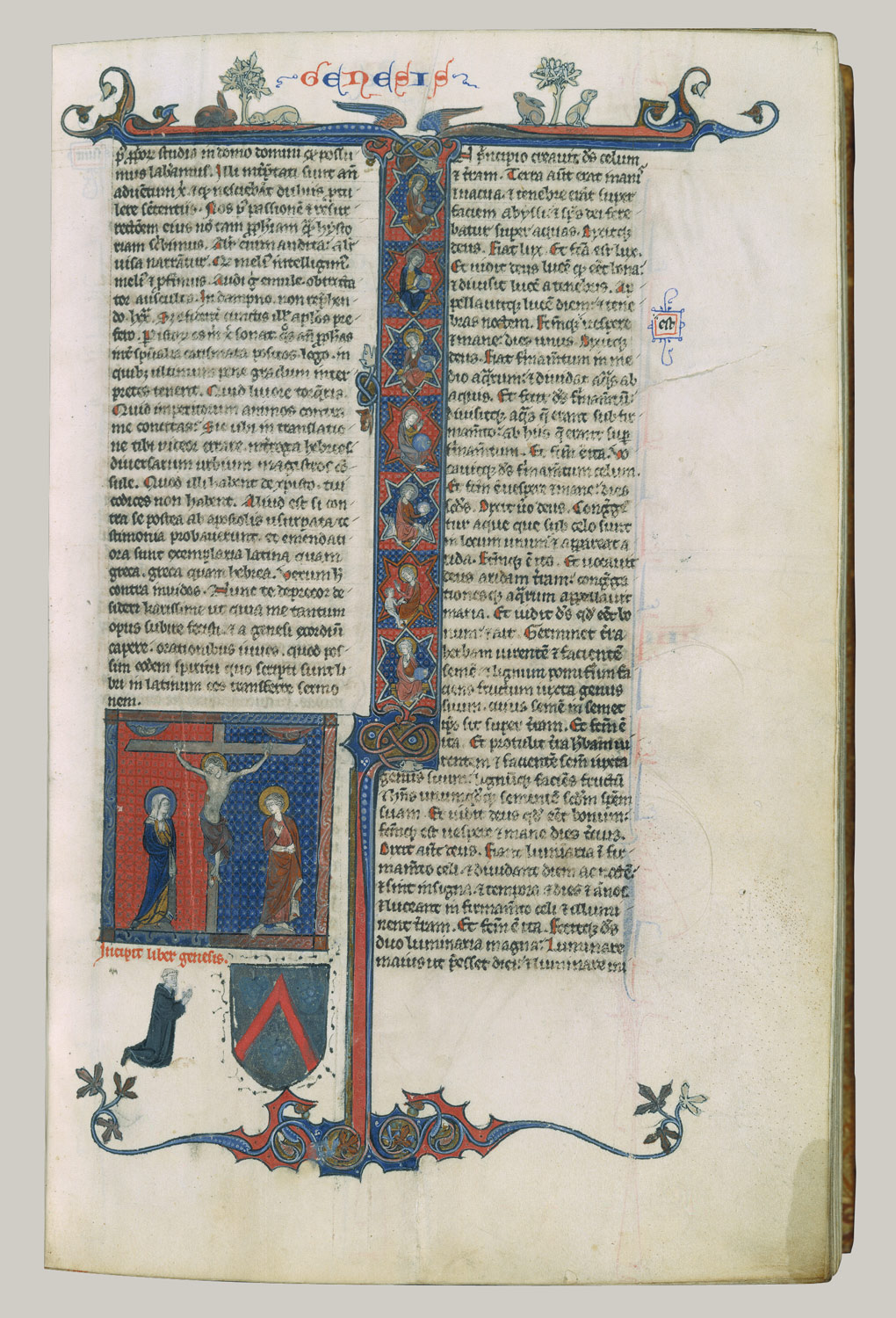
Bible, ca. 1250–1275
French; Paris
Tempera and gold leaf on parchment; leather binding: 560 leaves; 10 x 6 1/2 in. (25.3 x 16.5 cm)
Partial and Promised Gift of John L. Feldman, in memory of his father, Alvin Lindberg Feldman, 1997 (1997.320)
In thethirteenth century, Paris, with its renowned university, becameEurope's premier center for the creation of illuminated manuscripts.Typical of the work of the city's busy ateliers are the "UniversityBibles," which were created for a wide range of clients, includingclerics, laity, and students, and are characterized by painstakingscribal work and tiny but detailed illustrations. This Bible is one ofthe finest examples of the type, which survives in relatively largenumbers.
More richly illustrated (with eighty-one historiated initials)and significantly larger than most such Bibles, it is particularlyinteresting for its opening of the Book of Genesis, which presents theseven days of Creation in superimposed octofoils and the silhouette ofa Dominican kneeling beneath an image of the Crucifixion.
在13世紀,巴黎,其著名的大學,已成為歐洲首屈一指的中心,為創造發亮manuscripts.typical的工作,該城市的繁忙ateliers是"大學聖經",即創造了一個範圍廣泛對客戶,其中包括神職人員,俗人,和同學們,其特點是艱苦scribal工作和微小的,但詳細的插圖。本聖經是世界上最優秀的實例的類型,其中生存在比較大的號碼。
更豐富的說明( 81 historiated英文縮寫) ,並顯著大於大多數這樣的聖經,這是特別令人感興趣的,為開幕式的這本書的成因,其中介紹了7天的創作疊加octo箔及剪影一多米尼加一跪下方是一個形象的十字架。
[ 本帖最后由 daimon 于 23-10-2007 11:17 PM 编辑 ] |
|
|
|
|
|
|
|
|
|
| |
 本周最热论坛帖子 本周最热论坛帖子
|